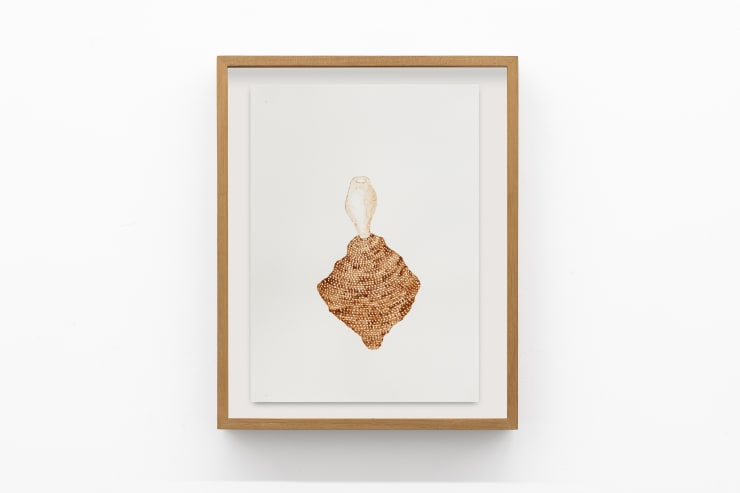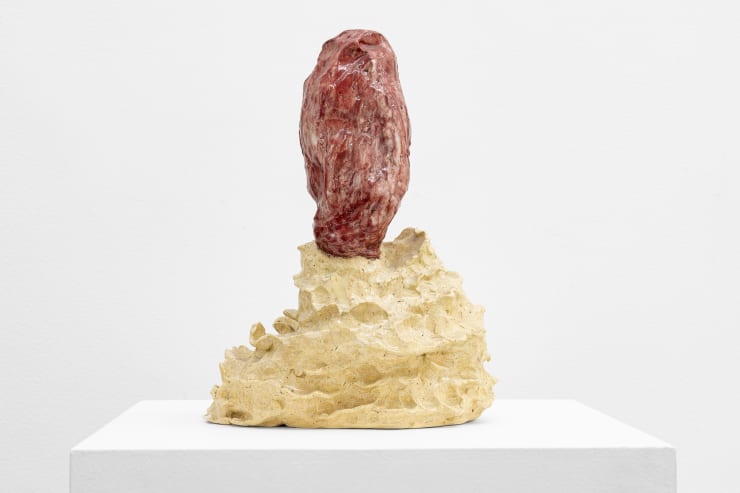-
brígida baltar (1959–2022)
to make the world a shelter
9 março – 29 abril, 2023
nara roesler new york
-
-
Brígida Baltar’s untimely passing last year changed the impetus of this exhibition, transforming it into an elegiac celebration of her unique oeuvre. Arguably one the finest Brazilian artists, Baltar kept herself devoted to uncompromised poetics, embracing her life and body with her aesthetic ambition to grasp the world as an extension of her intimacy. Dealing with the notion of shelter, the nostalgia of both home and origin as grounds for ceaseless metamorphosis, her work was as eloquent as subtle in her will to exist against the backdrop of a futile culture of hyper-exposure. Subtilitas (subtleness) and long-lasting processes, meditations on the entanglement between human body and nature; interiority and intimacy of domestic actions transformed into poetic acts; emphasis on the existential temporality of art; repeated, stubborn trials to grasp the ungraspable, the fleeting matter of worldly accidents (mist, dust, fog, salty sea air) that she kept in pristine and uncanny crystal-like objects; longing for her untrammeled body are constituents of a unique, unparalleled oeuvre surely destined to become among the most significant artistic legacies at the passage between XXth and XXIth Century Brazilian art.
-
-

-
-

-
Brígida Baltar centered her initial research on the longing experience of home. While living in a house located in the Botafogo district in Rio de Janeiro, she accomplished her seminal works in the early 1990s: notably through the analogy between home and honeycomb as a generative matrix for nourishment and life, leading her towards small performative interventions that were photographed, featuring her own body. These initial actions unfolded into an encompassing body of work as she was forced to abandon the house.
-
-

-
A major anchoring repertoire of actions and objects followed, mostly based on the dust collected from the briquets of the original home. Baltar produced countless drawings on paper, site-specific installations, and sculptures using the dust drawn from the briquets of her former house. It was, therefore, a first step within an embracing poetics focusing on marking the trace of her home into the larger, outer world, as if by disseminating the material dust that constituted its solid presence the artist could signal the possibility of an expanded field for the notion of shelter.
-

-
To make the world a shelter, to find the imprint of her body in the unlimited outer space of the world became Baltar’s primary poetic impulsion, the matter of her constant building of fables and visual wonders. Reliquary-like tactics unfolded allowing the artist to cancel the nostalgia of origins—the lost state of happiness—by disseminating the multiplying collected fragments of her home as matter for her art, transforming those relics in diverse and different bodies, through an unlimited exercise of poetic transfiguration, a ‘conceptualism of affections’ as labeled by curator Márcio Doctors. Brígida Baltar thus devoted herself ‘to the search of a kind of ideal space, a desacralized post- paradise, a stage of action and motion events (...) a place with no going back, pure singularities with no return’, in the words of her peer artist and friend Ricardo Basbaum.
-

-

-
The centrality of her body potentiated her oeuvre as an encompassing, almost universal presence of femaleness. Assuming the fullness of mimesis, Brígida Baltar approached all media—video, installation, photograph, drawing, sculpture, ceramics, ready-made, textile—in order to experience the unlimited possibilities of associations and analogies, delving into a full repertoire of hybridity and collision of forms, notably in ceramics, weavings, drawings and sculptures: crustaceous-like shell shapes take the rough and sublime appearance of body parts; an actress drags across the sand as a crab, sheltering herself underneath the earth; carefully sculpted accumulations of dust adopted the shape of the mountains surrounding the landscape where she lived, resembling the ‘morros’ (hills) of Rio de Janeiro, etc.
-
Guy Brett, a key author on Brazilian modern art during the XXth Century, recognized Brígida Baltar's work as one of the most significant artistic bodies in the wake of Helio Oiticica’s and Lygia Clark’s legacies. For Brett, indeed, Baltar brought back the notion of poetic shelter (Clark) to the realm of natural life, framing it within the very limits of everyday experiences. Moreover, also following Brett, Baltar’s entire oeuvre echoes Oiticica’s notion of Mundo-Abrigo (World-Shelter), significantly accomplished through a voluntary strategy of laterality, consistent with the artist’s will ‘to criticize the contemporary world of productivity surplus, which allows little room for daydreaming, for contemplation...’
-

-

-
Having gone at the end of her life through the struggle of illness and the violence of medications, Brígida Baltar continued to map her body in the world as much as she was, inevitably, experiencing the world being mapped on her own body. Her last weavings depicting the abstract shapes of blues on her skin are moving testimonies of the power of art to overcome the limitations of existence, elegies of her body's glare and poignant manifestoes of her poetic readiness to accept the wholeness of living. In her own terms, ‘a whirlwind of desires’: abstract residues of life, silent music for a glorious wound.
-

-

-

-

brigida baltar
b. 1959, rio de janeiro, brazil
d. 2022, rio de janeiro, brazilThe work of Brígida Baltar spaned across a wide range of mediums, which includes video, performance, installation, drawing, and sculpture. According to curator Lisette Lagnado, through this practice, ‘the artist strives to return to a pre-industrial, childlike and primitive narration.’ Baltar's artistic production began in the 1990s with the so-called small poetic gestures, developed in her studio-home in Botafogo, a neighbourhood of Rio de Janeiro.
During almost ten years, the artist collected items of domestic life such as the water dripping through small cracks on her roof, or dust falling from the bricks of her walls. This act of collecting subsequently expanded into the streets, giving birth to the Coletas series, an attempt of capturing mist, dew and ocean breeze—an ultimately impossible or rather, intangible task.
Brigida Baltar's recent work revisited her older series, as she uses the previously collected brick dust to draw images of Rio de Janeiro, creating pieces that intertwine her past and present works and that do not function as mere representations. Baltar also reflected upon her own biography, producing embroideries related to her body, more specifically her skin.selected solo exhibitions
- Brígida Baltar: Filmes, Espaço Cultural BNDES, Rio de Janeiro, Brazil (2019)
- A carne do mar, Nara Roesler, São Paulo, Brazil (2018)
- SAM Art Project, Paris, France (2012)
- O amor do pássaro rebelde, Cavalariças, Parque Lage, Rio de Janeiro, Brazil (2012)
- Brígida Baltar – Passagem Secreta, Fundação Eva Klabin, Rio de Janeiro, Brazil (2007)
selected group exhibitions
- The Fold in the Horizon, Nara Roesler, New York, USA (2022)
- 12th Mercosul Biennial, Brazil (2020)
- Alegria – A natureza-morta nas coleções MAM Rio, Museu de Arte Moderna do Rio de Janeiro (MAM Rio), Rio de Janeiro, Brazil (2019)
- I Remember Earth, Magasin des horizons, Centre d’arts et de Cultures, Grenoble, France (2019)
- Neither-nor: Abstract Landscapes, Portraits and Still Lives, Terra-Art Project, London, United Kingdom (2017)
- Constructing views: experimental film and video from Brazil, New Museum, New York, USA (2010)
selected collections
- Pinacoteca do Estado de São Paulo, São Paulo, Brazil
- Museum of Fine Arts Houston (MFAH), Houston, USA
- Museu de Arte do Rio (MAR), Rio de Janeiro, Brazil
- Museum of Contemporary Art of Cleveland (MOCA), Cleveland, USA





















![A quimera das plantas [os cogumelos e a batata-doce], 2016 bordado sobre algodão 60 x 41 cm](https://artlogic-res.cloudinary.com/w_740,c_limit,f_auto,fl_lossy,q_auto/ws-artlogicwebsite0088/usr/images/artworks/main_image/items/6c/6cdd4a02459c4e7db7a6c4e3f3e2b5e4/33601_bb_-erikamayumi_high-1.jpg)
![The chimera of plants [the mushrooms and the heart of the banana tree], 2016 bordado sobre algodão 60 x 41 cm](https://artlogic-res.cloudinary.com/w_740,c_limit,f_auto,fl_lossy,q_auto/ws-artlogicwebsite0088/usr/images/artworks/main_image/items/4f/4f0c7482a824483eb628083c6167943b/33602_bb_-erikamayumi_high-1.jpg)














